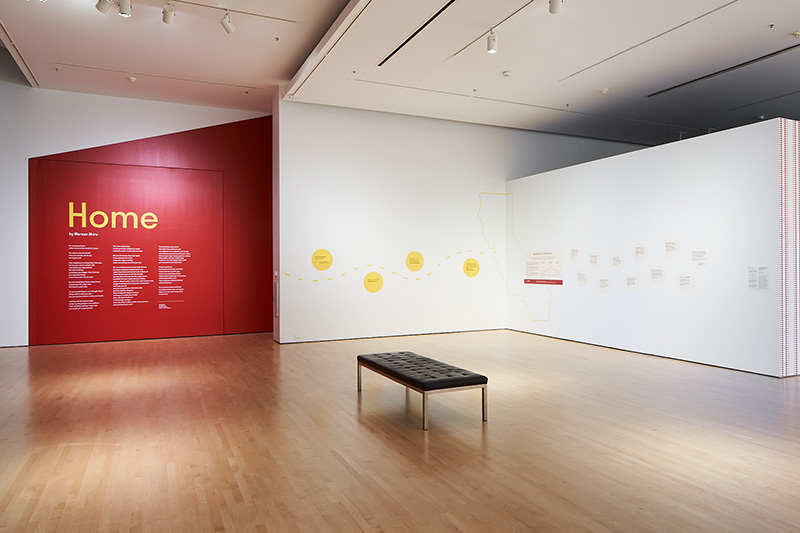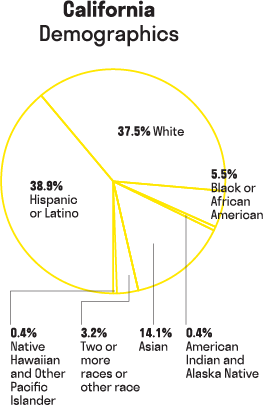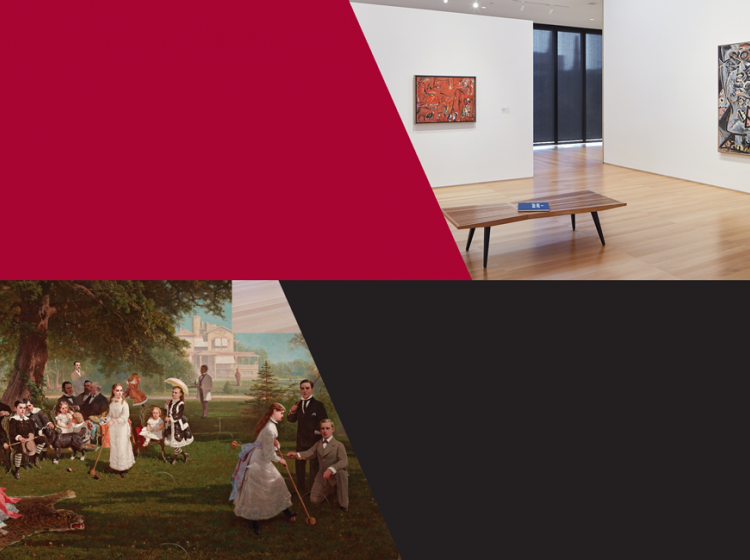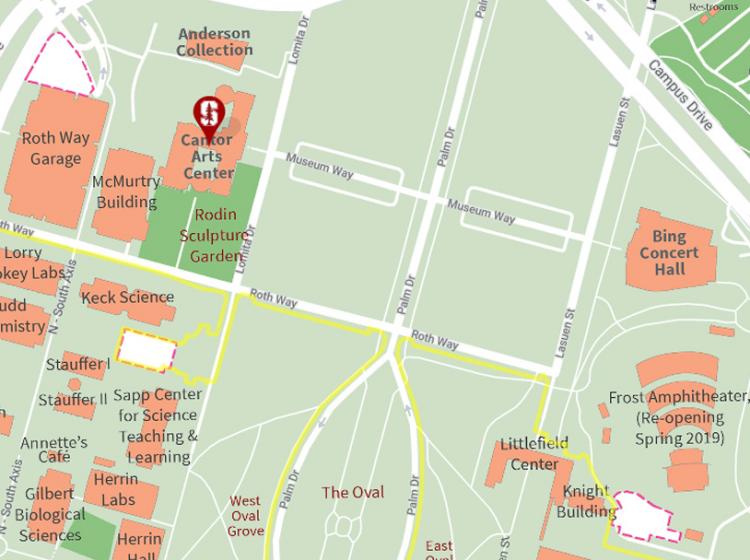Cantor Arts Center
328 Lomita Drive at Museum Way
Stanford, CA 94305-5060
Phone: 650-723-4177
Migration is not a new phenomenon, but it does change over time. Migrants move by choice—seeking better education or financial security—or by force—fleeing war or persecution based on race, religion, gender, or sexual orientation. People are also displaced by economic forces like gentrification and ecological forces like natural disasters and the effects of climate change. In “Learn More,” we’ve provided bibliographies and resource lists to help you explore the subject further.
In this section you will find recommended reading materials related to the exhibition.
In this section, you will find a list of resources, advocates, and supporting organizations that are involved with migration at different levels, both in government and nonprofit sectors.
In this section you will find a list of sources that were used in support of the "Spotlight on California" corner in the exhibition and recommended articles for further reading.
IOM works to help ensure the orderly and humane management of migration, promote international cooperation, find practical solutions, and provide humanitarian assistance to migrants in need.
UNHCR strives to engage with migration issues that affect refugees and other persons under its mandate, including asylum-seekers, internally displaced people and stateless people.
Amnesty International campaigns to ensure governments honour their shared responsibility to protect the rights of refugees, asylum-seekers and migrants.
The IRC responds to the world’s worst humanitarian crises and helps people whose lives and livelihoods are shattered by conflict and disaster to survive, recover and gain control of their future.
Refugees International advocates for lifesaving assistance and protection for displaced people and promotes solutions to displacement crises.
HIAS works around the world to protect refugees who have been forced to flee their homelands because of who they are, including ethnic, religious, and sexual minorities.
IM International is a community space; a think tank envisioning a different legal reality for human migration; a lab practicing artivist tactics; and an educational platform based on a culture of reciprocity.
IDMC is the world's definitive source of data and analysis for informing policy and operational decisions that improve the lives of the millions of people living in or at risk of internal displacement.
BRYCS aims to strengthen the capacity of refugee-serving and mainstream organizations across the U.S. to empower and ensure the successful development of refugee children, youth, and their families.
The Migration Policy Institute seeks to improve immigration policies through research and analysis, learning and dialogue, and the development of new ideas to address complex policy questions.
The mission of the USCRI is to protect the rights and address the needs of persons in forced or voluntary migration worldwide and support their transition to a dignified life.
RCUSA promotes efforts to protect and welcome refugees, asylum-seekers, and other forcibly displaced populations through just and humane laws and policies, and dialogue and communication.
RAICES is a nonprofit agency that promotes justice by providing free and low-cost legal services, social programs, bond assistance, and advocacy to underserved immigrant children, families, and refugees.
Established in response to US government termination and assimilation policies, NCAI protects the inherent and legal rights of tribal governments.
The Oxford African American Studies Center offers the most comprehensive online collection of scholarship on the lives and events which have shaped African American and African history and culture.
IPL uses large datasets, creative research designs, and cutting-edge analytical tools to bring new evidence to bear on the urgent problems of setting public policy and serving immigrant communities.
SIREN’s mission is to empower low-income immigrants and refugees through community education and organizing, leadership development, policy advocacy, civic engagement and legal services.
RIT provides free education, family engagement, and community leadership programs. Their students have sought refuge due to war, violence, persecution, or economic duress.
SF-CAIRS works to expand resource knowledge about health, employment, social, education and legal services for recent refugees, political asylees and immigrants in San Francisco.
IIBA provides high-quality, affordable immigration legal services, education, and civic engagement opportunities.
CCIS is the only academic center in the United States specializing in international migration from a broad geographical as well as interdisciplinary perspective.
ACLU Northern California, one of the largest ACLU affiliates in the nation, works to protect and advance civil liberties — free speech, privacy, due process — for all Californians.
The Population Division plays an active role in intergovernmental dialogue on population and development, producing demographic projections and focused materials on international migration.
ILO brings together governments, employers and workers to set labor standards, develop policies and devise programs promoting decent work for all women and men, including those engaged in labor migration.
The CTDC publishes data from counter-trafficking organizations around the world to break down information-sharing barriers and equip the counter-trafficking community with reliable data on human trafficking.
This project seeks to give a voice to the Chinese migrants whose grueling and perilous labor on the Transcontinental Railroad helped to shape the physical and social landscape of the American West.
The Bay Area Equity Atlas is a tool with robust, disaggregated data for community leaders seeking to create a more equitable, sustainable, and resilient region.
The Anti-Eviction Mapping Project is a data-visualization, critical cartography, and multimedia storytelling collective documenting dispossession and resistance upon gentrifying landscapes.
This project aims to understand the nature of gentrification and displacement in American cities and create tools to help communities identify pressures and take effective action.
The NCRC works with community leaders, policymakers and financial institutions to champion fairness and end discrimination in lending, housing and business.
Fair Housing Advocates of Northern California (formerly Fair Housing of Marin) is an independent nonprofit dedicated to equal housing opportunity.
WHO works worldwide to ensure that people, including refugees and migrants, have universal health coverage, protect people from health emergencies, and provide people with better health and well-being.
Doctors Without Borders (MSF) provides medical care, mental health support, and treatment for sexual violence, to refugees and displaced people wherever they are—even on the move.
As part of the world’s largest humanitarian network, the American Red Cross partners with Red Cross and Red Crescent teams to provide aid and hope to migrants, refugees, and asylum seekers.
The artworks in this module represent widely ranging views on immigration from artists contemplating ther ancestor's experiences, events they witnessed, or their own stories in their art.
For many artists, their own migrations and those of their ancestors shape their identities, cultural traditions, and art.
Explore how artists reflect on moving to new places in this selection of resources.
Creative Exchange is a platform that shares stories of artists and their impact in community, and free, practical toolkits for artist-engaged programs. This focused article links to a number of resources.
Government actions designed to restrict immigration and rescind protections affect many people who work in the arts, as well as all U.S. citizens’ abilities to live a full and free creative life.
Government actions designed to restrict immigration and rescind protections affect many people who work in the arts, as well as all U.S. citizens’ abilities to live a full and free creative life.
At the Cantor, this exhibition takes on additional nuances thanks to the unique migration histories of California and the Bay Area. California has long been and continues to be one of the most diverse states in the nation, but it’s important to consider the complex histories that shaped it. Our Spotlight on California corner features factoids about our national, regional, and local context. As you read, consider how past patterns of and restrictions on movement and habitation have influenced our current moment.

In 2018, 27% of people living in California and around 30% of those in the Bay Area were born outside of the country. But, California's diversity has also been shaped by local, national and global histories of slavery, genocide, forced displacement, racial violence and discriminatory laws. These histories and their effects continue to shape the Bay Area, California, and the nation, fueling ongoing racial justice and human rights movements.



All URLs accessed November 30, 2020.
[i] “Most Diverse States 2020,” World Population Review, 2020, https://worldpopulationreview.com/state-rankings/most-diverse-states; Jeanne Batalova and Randy Capps, “U.S. Immigration Trends,” Migration Policy Institute, 2021, https://www.migrationpolicy.org/programs/data-hub/us-immigration-trends; “State Immigration Data Profiles,” Migration Policy Institute, 2020, https://www.migrationpolicy.org/data/state-profiles/state/demographics/CA; Hans Johnson and Sergio Sanchez, “Immigrants in California,” Public Policy Institute of California, May 2019, https://www.ppic.org/publication/immigrants-in-california/; “San Francisco Bay Area,” BayAreaCensus.CA.gov, 2010, http://www.bayareacensus.ca.gov/bayarea.htm; “United States: ACS Demographic and Housing Estimates,” United States Census Bureau, 2018, https://data.census.gov/cedsci/table?d=ACS%205-Year%20Estimates%20Data%20Profiles&tid=ACSDP5Y2018.DP05&hidePreview=true; “California: ACS Demographic and Housing Estimates,” United States Census Bureau, 2018, https://data.census.gov/cedsci/table?g=0400000US06&d=ACS%205-Year%20Estimates%20Data%20Profiles&tid=ACSDP5Y2018.DP05; “Alameda County, CA: ACS Demographic and Housing Estimates,” United States Census Bureau, 2018, https://data.census.gov/cedsci/table?q=ACSDP5Y2018.DP05%20Alameda%20County,%20California&g=0500000US06001&tid=ACSDP5Y2018.DP05&hidePreview=true; “Contra Costa County, CA: ACS Demographic and Housing Estimates,” United States Census Bureau, 2018, https://data.census.gov/cedsci/table?q=ACSDP5Y2018.DP05%20Contra%20Costa%20County,%20California&g=0500000US06013&tid=ACSDP5Y2018.DP05&hidePreview=true; “Marin County, CA: ACS Demographic and Housing Estimates,” United States Census Bureau, 2018, https://data.census.gov/cedsci/table?q=ACSDP5Y2018.DP05%20Marin%20County,%20California&g=0500000US06041&tid=ACSDP5Y2018.DP05&hidePreview=true; “Napa County, CA: ACS Demographic and Housing Estimates,” United States Census Bureau, 2018, https://data.census.gov/cedsci/table?q=ACSDP5Y2018.DP05%20Napa%20County,%20California&g=0500000US06055&tid=ACSDP5Y2018.DP05&hidePreview=true; “San Francisco County, CA: ACS Demographic and Housing Estimates,” United States Census Bureau, 2018, https://data.census.gov/cedsci/table?q=ACSDP5Y2018.DP05%20San%20Francisco%20County,%20California&g=0500000US06075&tid=ACSDP5Y2018.DP05&hidePreview=true; “San Mateo County, CA: ACS Demographic and Housing Estimates,” United States Census Bureau, 2018, https://data.census.gov/cedsci/table?q=ACSDP5Y2018.DP05%20San%20Mateo%20County,%20California&g=0500000US06081&tid=ACSDP5Y2018.DP05&hidePreview=true; “Santa Clara County, CA: ACS Demographic and Housing Estimates,” United States Census Bureau, 2018, https://data.census.gov/cedsci/table?q=ACSDP5Y2018.DP05%20Santa%20Clara%20County,%20California&g=0500000US06085&tid=ACSDP5Y2018.DP05&hidePreview=true; “Solano County, CA: ACS Demographic and Housing Estimates,” United States Census Bureau, 2018, https://data.census.gov/cedsci/table?q=ACSDP5Y2018.DP05%20Solano%20County,%20California&g=0500000US06095&tid=ACSDP5Y2018.DP05&hidePreview=true; “Sonoma County, CA: ACS Demographic and Housing Estimates,” United States Census Bureau, 2018, https://data.census.gov/cedsci/table?q=ACSDP5Y2018.DP05%20Sonoma%20County,%20California&g=0500000US06097&tid=ACSDP5Y2018.DP05&hidePreview=true.
[ii] “Frequently Asked Questions: Indian Tribes and Tribal Communities in California,” California Tribal Court-State Court Forum, 2020, https://www.courts.ca.gov/3066.htm.
[iii] “Slave Trade: International Day of Remembrance of the Victims of Slavery and the Transatlantic Slave Trade,” UnitedNations.Org, https://www.un.org/en/observances/decade-people-african-descent/slave-trade; Henry Louis Gates Jr., “The African-American Migration Story,” PBS.org, 2013, https://www.pbs.org/wnet/african-americans-many-rivers-to-cross/history/on-african-american-migrations/.
[iv] Ron Dugan, “A Moving Border, and the History of a Difficult Boundary,” USA Today, 2017, https://www.usatoday.com/border-wall/story/us-mexico-border-history/510833001/; Bracero History Project, http://braceroarchive.org/about; Ramón A. Gutiérrez, “Mexican Immigration to the United States,” Oxford Research Encyclopedia of American History, July 29, 2019, https://oxfordre.com/americanhistory/view/10.1093/acrefore/9780199329175.001.0001/acrefore-9780199329175-e-146.
[v] Erika Lee, “The Chinese Are Coming. How Can We Stop Them? Chinese Exclusion and the Origins of American Gatekeeping,” in Asian American Studies Now, ed. Jean Yu-wen Shen Wu and Thomas C. Chen (New Brunswick, NJ: Rutgers University Press, 2012), 143–167, https://doi.org/10.36019/9780813549330.
[vi] “Great Migration African-American History,” Encyclopedia Britannica, last modified May 18, 2020, https://www.britannica.com/event/Great-Migration; Henry Louis Gates Jr., “The African-American Migration Story,” PBS.org, last modified October 18, 2013, https://www.pbs.org/wnet/african-americans-many-rivers-to-cross/history/on-african-american-migrations/.
[vii] Matt Bowling, “Japanese-American Internment: Palo Alto’s Deported Patriots,” PaloAltoHistory.org, 2012, http://www.paloaltohistory.org/japanese-american-internment.php.
[viii] “Frequently Asked Questions: Indian Tribes and Tribal Communities in California,” Judicial Council of California, California Tribal Court-State Court Forum, 2020, https://www.courts.ca.gov/3066.htm.
[ix] Kim-Mai Cutler, “East of Palo Alto’s Eden: Race and the Formation of Silicon Valley,” Techcrunch.com, January 10, 2015, https://techcrunch.com/2015/01/10/east-of-palo-altos-eden/; “History of Fair Housing,” Fair Housing Advocates of Northern California, http://www.fairhousingnorcal.org/history-of-fair-housing.html; Herbert G.Ruffin, “The California Fair Housing Act [The Rumford Act] (1963–1968),” Black Past, June 5, 2011, http://www.blackpast.org/african-american-history/california-fair-housing-act-rumford-act-1963-1968/.
[x] “Refugee Timeline,” US Citizenship and Immigration Services, last reviewed/updated July 28, 2020, https://www.uscis.gov/history-and-genealogy/featured-stories-uscis-history-office-and-library/refugee-timeline; Muzaffar Chishti, Faye Hipsman, and Isabel Ball, “Fifty Years On, the 1965 Immigration and Nationality Act Continues to Reshape the United States,” MigrationPolicyInstitute.org, October 15, 2015, https://www.migrationpolicy.org/article/fifty-years-1965-immigration-and-nationality-act-continues-reshape-united-states.
[xi] “Refugee Resettlement in California,” Refugee Council USA, January 1, 2019, https://rcusa.org/resources/state-by-state-refugee-resettlement/.
[xii] Kim-Mai Cutler, “East of Palo Alto’s Eden: Race and the Formation of Silicon Valley,” Techcrunch.com, January 10, 2015, https://techcrunch.com/2015/01/10/east-of-palo-altos-eden/; Louis Hansen, “Oakland, S.F. Neighborhoods Fastest Gentrifying in U.S.,” Mercury News (San Jose, CA), June 20, 2020, https://www.mercurynews.com/2020/06/18/oakland-s-f-neighborhoods-fastest-gentrifying-in-u-s/; “What Is the Nature of Gentrification, Displacement, and Exclusion in Global Cities?,” Urban Displacement Project, 2018, https://www.urbandisplacement.org/; Sue Dremann, “East Palo Alto Residents Protest Palo Alto Landlord’s Massive Rent Increase,” PaloAltoOnline.com, May 20, 2017, https://www.paloaltoonline.com/news/2017/05/18/east-palo-alto-residents-protest-palo-alto-landlords-massive-rent-increase; Melissa Navas, “The Harsh Reality of Gentrification,” University of San Francisco, May 12, 2020, https://www.usfca.edu/journal/divisadero/spring-2020/harsh-reality-of-gentrification.

The Cantor Arts Center is located at the intersection of Museum Way and Lomita Drive in the heart of the arts district on the Stanford campus. The Cantor faces the Bing Concert Hall across Palm Drive, northwest of The Oval and the Main Quad.

Parking is limited. Stanford has a new contactless process to pay for parking, using the ParkMobile app, website, or phone. Prior to your visit, we recommend you visit the Stanford Transportation website to learn more about the updated visitor parking process.
